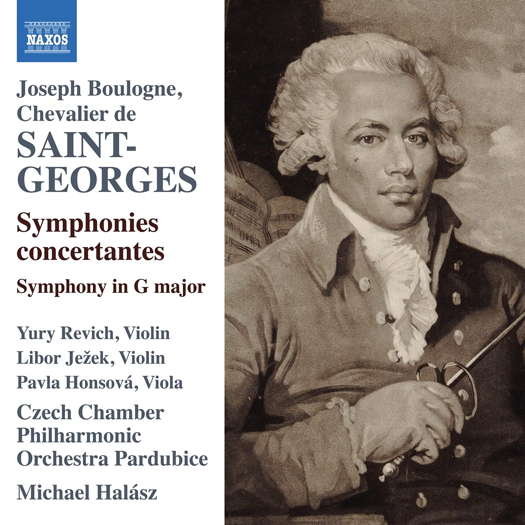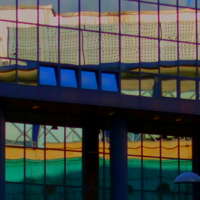- Wanhall
- Alfred Schnittke
- Padre Martini
- Cor Edskes
- Svendsen
- Francesco Ivan Ciampa
- Beauty and the Beast
- Paul Macalindin

Something of a Mystery
GERALD FENECH listens to music by Joseph Boulogne, Chevalier de Saint-Georges
'Michael Halász gives lively performances that sparkle with a "joie de vivre" that is consistently uplifting ...'
Born on 25 December 1745 in Guadeloupe, Joseph Saint-Georges was the son of a planter and former Councillor at the Parliament in Metz, and Anne, dite 'Nanon', his wife's sixteen-year old slave of Senegalese origin. Although he was married, Boulogne acknowledged his illegitimate son and gave him his surname. In 1753 his father took Joseph, aged seven, to France for his education, installing him in a boarding school, while he returned to his lands in Guadeloupe.
Two years later, on 26 August 1755, Boulogne, now Chevalier de Saint-Georges, and Nanon landed in Bordeaux. In Paris, reunited with their son, they moved into a spacious apartment. Aged thirteen, the boy was enrolled at the Academy of fencing and horsemanship. His progress was astonishing, and at fifteen he had already mastered both sporting categories. Indeed, at seventeen he developed the greatest speed imaginable (in fencing), and in defeating Alexandre Picard, the famous fencing master from Rouen, he became the darling of the public. Proud of his feat, his father rewarded him with a horse and a buggy. In 1765, on graduating from the Academy, Boulogne Jnr was made a 'Gendarme du roi' and a chevalier. Henceforth Joseph Boulogne, by adopting the suffix of his father, would be known as the 'Chevalier de Saint-Georges', the latter title inherited from the name of one of his father's plantations in Guadeloupe.
The composer's other love was dancing, and he often attended balls and salon entertainment, where he was very popular. Saint-Georges' later life was heavily affected by the Revolution and, since he was of mixed race, he was hit hard by racism and racist laws enacted before 1789. Notwithstanding these disadvantages, he distinguished himself as a soldier, even reaching the rank of Colonel. Condemned by critics for being involved in non-revolutionary activities such as music events, he was dismissed and imprisoned for eighteen months. After his release, he went back to St Domingue for a while, but the civil war there drove him back to France in 1797, where he tried to rejoin the army. His application refused, he died broken-hearted, on 10 June 1799, of a bladder disease.
The composer's musical life is something of a mystery. What we know for sure is that in 1764, aged nineteen, he was the dedicatee of two violin concertos by Antonio Lolli, proof of his ability to play the instrument. In 1766, François-Joseph Gossec also thought of him when he published the six Trio Sonatas Op 9, and later welcomed him to the violin section of his orchestra in 1769.
His first documented compositions are from 1770 and 1771, and while these are clearly works by a composer still searching for his voice, they already demonstrate his commitment to the new and unexplored. His skill at the harpsichord and violin earned him dedications from major composers, and apart from Gossec, he also studied with Jean-Marie Leclair, and became first violin or concert master of 'Le Concert des amateurs'.
His String Quartets were among the first in France, and in 1776 he published two Symphonies Concertantes. Two more followed in 1778. In 1777 he wrote three violin concertos and six string quartets. One of the highlights of his career was definitely his performing of music with Queen Marie-Antoinette in 1779. He was an early Black Mason in France, and when his orchestra closed, his colleagues organized the 'Concert de la Loge Olympique'. Called the 'Black Mozart', he was responsible for the premiere of Haydn's Paris Symphonies in 1785, and by the time of his death on 10 June 1799 aged fifty-three, his output was pretty substantial in all genres.
Sadly, many of his manuscripts were destroyed during the Revolution, and only a small number have come down to us. The four Symphonies Concertantes on this disc are early and important exponents of the hybrid symphonie concertante – a gem that draws on both the symphony and the concerto traditions.
Listen — Joseph Boulogne: Allegro (Symphonie Concertante in A, Op 9 No 2)
(track 3, 0:00-0:55) ℗ 2021 Naxos Rights (Europe) Ltd :
This novel format was the ideal platform for expressive inventiveness, providing new textural possibilities through the addition of a second solo violin or viola.
Listen — Joseph Boulogne: Rondeau (Symphonie Concertante in A, Op 10 No 2)
(track 8, 1:20-2:18) ℗ 2021 Naxos Rights (Europe) Ltd :
The Symphony in G, which has all the effervescence typical of Haydn, is an excellent example of the cosmopolitan French symphonic style.
Listen — Joseph Boulogne: Allegro assai (Symphony in G, Op 11 No 1)
(track 11, 3:00-4:00) ℗ 2021 Naxos Rights (Europe) Ltd :
There is an attractive melodic aura to these finely crafted pieces, written in the galant-style of the day and full of elegant characteristics that are typically gaelic. Michael Halász gives lively performances that sparkle with a 'joie de vivre' that is consistently uplifting, while exposing all of the composer's imaginative vein. A very fine addition to the Saint-Georges discography, in excellent sound quality and informative annotations.
Copyright © 29 September 2021
Gerald Fenech,
Gzira, Malta

CD INFORMATION - SAINT-GEORGES: SYMPHONIES CONCERTANTES
JOSEPH BOULOGNE, CHEVALIER DE SAINT-GEORGES




